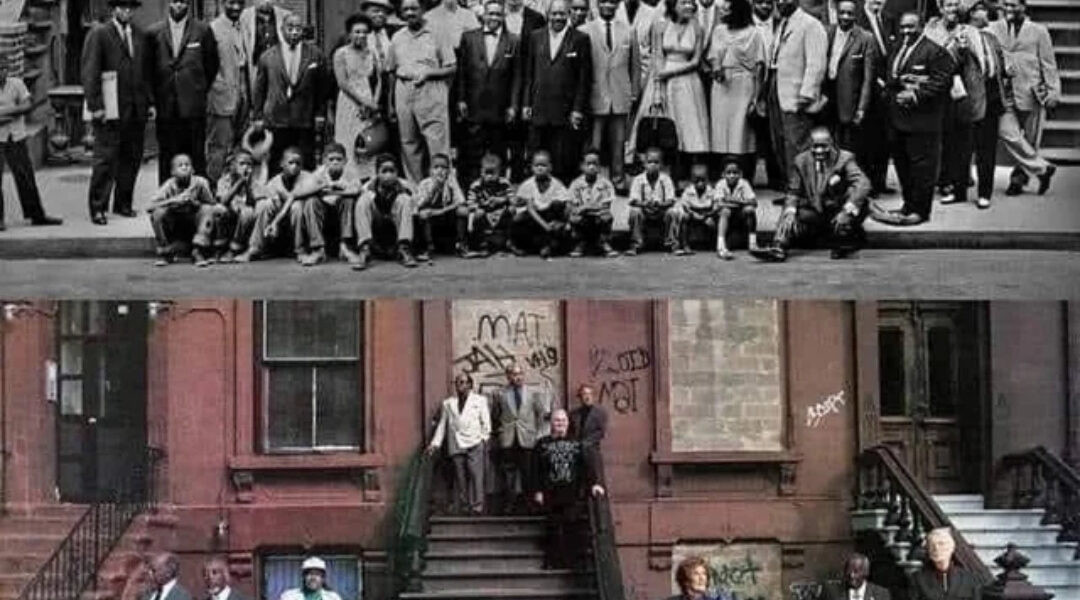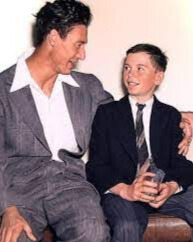It was a warm August morning in 1958, and Harlem was just beginning to stir awake. Children chased each other along the sidewalks, women leaned out of brownstone windows, and the hum of the city mingled with jazz spilling faintly from a nearby record store.

That’s when Art Kane, a 33-year-old photographer for Esquire magazine, arrived with an impossible idea — to capture the soul of jazz in a single image.
He had written letters, made phone calls, and sent word through smoky clubs and late-night stages: “Come to 126th Street between Fifth and Madison. Bring your horn. 10 a.m. sharp.”
And somehow, they came.
One by one, they appeared — the giants of the golden age. Count Basie, Thelonious Monk, Dizzy Gillespie, Sonny Rollins, Charles Mingus, Art Blakey, Marian McPartland, Lester Young, Maxine Sullivan, and so many others. Fifty-seven of the greatest jazz musicians in history, all gathered on the same Harlem stoop.

The sight was unreal. Titans of music — black suits, shining shoes, saxophone cases in hand — laughing and leaning on each other like old friends. Children from the neighborhood sat cross-legged in front, watching history unfold.
Kane, almost trembling with awe, called out, “Alright everyone — just be yourselves.”
And they did.
Someone cracked a joke. Monk adjusted his hat. Dizzy puffed his cheeks, as always. Basie sat on the curb with a grin that said everything there was to say about joy.
When Kane pressed the shutter, a single click froze an entire era in time.
That photo became known as “A Great Day in Harlem.” It wasn’t just a picture — it was a declaration. It said: Here we are. We exist. We create. We belong. In a nation still divided by race and struggle, this image was proof of Black excellence, unity, and art that refused to fade.
🎷 The Echo Years Later
Nearly four decades passed. The streets changed. The clubs grew quieter. Many of the faces that once filled the frame were gone — taken by time, by circumstance, by the natural rhythm of life itself.
Then in 1996, the survivors returned. They stood once again on that same block, in front of the same brownstone, their hair grayer, their steps slower.
Only a handful remained — a small cluster of living echoes.
They didn’t need to pose this time. They just stood there, letting the silence speak. The ghosts of their friends seemed to fill the air. The photograph was taken again — not as a recreation, but as a reflection. The music had changed, but the melody lingered.
Side by side, the two images tell the story of an art form — and of life itself.
In the first, youth and laughter; in the second, memory and reverence. Between them lies everything we all know too well — time moves fast, people slip away, but what we give the world through our love, our art, and our kindness, remains.
🎵 The Lesson Behind the Lens
When you look at those two photographs — 1958 and 1996 — you don’t just see history. You see a sermon without words. You see joy, struggle, pride, and the beauty of impermanence.
You’re reminded that life isn’t about how long the music plays — it’s about how deeply it’s felt.
Fifty years from now, someone else will look at our photos, our stories, our songs — and they’ll see what we were trying to say. That we laughed. That we created. That we loved.
So today, while the camera is still rolling, the music still playing, and the light still soft on your face —
forgive someone, laugh a little louder, love a little deeper.
Because someday, someone will call this moment — your moment —
their own great day.




